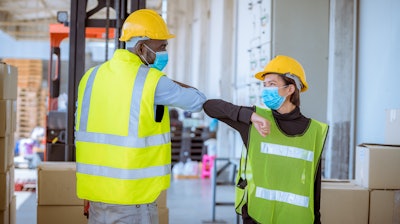
With manufacturing falling to a 14-month low and business across the industry continuing to grapple with the Omicron variant surge, business leaders are once again re-evaluating their workplace safety plans for keeping their employees safe.
While many industries can have their employees comfortably work outside of the traditional workplace, for many other others, such as manufacturing, that is not a practice they can sustain for very long, if at all.
Balancing the need to remain open for business with the need to keep employees safe is a delicate one. So, how does the manufacturing industry create a truly healthy workplace where the risk of allergens and airborne disease is minimized? It starts with reorienting the focus of your workplace safety plans.
Review and Revise
Over the course of the pandemic, many organizations created plans for minimizing risk from implementing social distancing measures to increasing cleaning procedures. What’s important, however, is not the creation of these plans, but the continual improvement and utilization of them.
As the pandemic continues, revising those plans to go beyond behavior-changing practices and focus on strategies that remove the hazard itself will be vital to keeping your employees safe. This is where engineering controls come into play.
Engineering controls, or physical changes to the workplace, are designed to remove the hazard at the source before it comes in contact with individuals.
Of the 10 controls that the Centers for Disease Control recommends, there are two that can be the most impactful when faced with an airborne health crisis: air quality and ventilation.
As a result, implementing changes such as utilizing air purifiers or improving exhaust ventilation are extremely effective because they capture and/or eliminate the harmful particles, don’t usually involve or interfere with day-to-day workplace activities and while the initial cost of these changes may be high, it ends up reducing operating costs in the long term.
Make Evidence-Based Decisions
Regardless of the physical changes you decide to make, it can be tough to determine hype from effectiveness. Do your research and find out what the industry standards are, but don’t base your decision off factor alone.
The science changes and many times the industry is slow to adapt. Therefore, couple your industry knowledge with the solutions and technologies within that market that are proven to have the most impact.
For example, one of the most integral changes that can be made is integrating air purifier solutions into your HVAC system. With so many purifier solutions on the market, how do you determine the right fit for your business?
The best way to make your decision is by reviewing the purifier unit’s total system efficiency measuring how efficient the entire purifier system is in comparison to the energy it uses.
Removing harmful viruses and toxins from the air requires more than a good filter: it requires the entire system to be running at maximum efficiency. The more efficient a system is, the better it will be at removing harmful particles from the air.
HEPA has historically been the standard rating that companies use to demonstrate a purifier’s effectiveness, however HEPA filters have a limit to the size of a particle it filters out.
Additionally, a HEPA rating only applies to the filter, not the entire air purifier system. Therefore, to ensure the purifier you’re considering lives up to its claims, look beyond the filter and ensure that the company is testing each unit individually to ensure the entire system is running efficiency.
This approach can be applied regardless of the control you want to implement. By not only reviewing industry standards but understanding what solutions and technologies will have the most impact, you’ll create a workplace where illnesses are reduced and employees feel safe.
Be Flexible With Implementation
Don’t despise small beginnings. This doesn’t need to be an all-or-nothing endeavor. There are several actions you can take that will make your workplace safer without a large up-front financial investment.
The important thing? Getting started. Simple things like creating a nightly cleaning procedure or buying a plug-and-play air purification system are great steps in improving the overall cleanliness and safety of a space.
When faced with easily-transmissible airborne disease COVID-19, it makes sense that employers remain nervous. For those who depend on in-person employees in the workplace, the persistence of COVID-19 means continually adapting to the changing safety landscape.
Unfortunately, there is no silver bullet or set way to prevent people from getting sick at work. However, by making changes that go beyond altering behavior and instead working to remove the hazard itself, you’ll be in a better position to face current and future health challenges head-on, creating a safer workplace for years to come.
---
Vinny Lobdell is president of HealthWay Family of Brands























